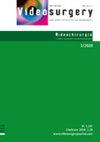Robotic adrenalectomy versus laparoscopic adrenalectomy for pheochromocytoma: a systematic review and meta-analysis
IF 1.6
4区 医学
Q2 SURGERY
引用次数: 1
Abstract
Introduction The application of robotic adrenalectomy (RA) has been increasing. However, there is still controversy about whether RA is more feasible than laparoscopic adrenalectomy (LA) for pheochromocytoma (PHEO). Aim To evaluate the efficacy and safety of RA vs. LA for PHEO. Material and methods A literature search of the PubMed, Ovid, and Scopus databases was performed to identify eligible studies up to April 2021. All studies comparing RA versus LA for PHEO were included. Data were analysed using the Cochrane Collaboration’s Review Manager (RevMan) 5.4 software. Results Overall, 4 studies including 386 patients (RA 155; LA 231) were included. RA might have larger tumour size (WMD = 0.72 cm, 95% CI: 0.31 to 1.13; p < 0.001). There were no statistically significant differences in operative time (WMD = –12.49 min, 95% CI: –29.50 to 4.52; p = 0.15), estimated blood loss (EBL) (WMD = –28.48 ml, 95% CI: –58.92, 1.95; p = 0.07), transfusion rate (OR = 0.70, 95% CI: 0.07 to 7.07; p = 0.77), or conversion rate (OR = 0.44, 95% CI: 0.07 to 2.88; p = 0.39). There were no significant differences between the 2 groups in terms of postoperative complications (OR = 1.06, 95% CI: 0.62 to 1.82; p = 0.84) and Clavien Dindo score ≥ 3 complications (OR = 1.15, 95% CI: 0.39 to 3.41; p = 0.80). Patients from the RA group could benefit from shorter length of hospital stay (WMD = –0.51 days, 95% CI –0.91 to –0.12; p = 0.01). Conclusions RA is a feasible, safe, and comparable treatment option for PHEO.机器人肾上腺切除术与腹腔镜肾上腺切除术治疗嗜铬细胞瘤:系统综述和荟萃分析
引言机器人肾上腺切除术(RA)的应用越来越多。然而,对于RA是否比腹腔镜肾上腺切除术(LA)更可行治疗嗜铬细胞瘤(PHEO),仍存在争议。目的评价RA与LA治疗PHEO的疗效和安全性。材料和方法对PubMed、Ovid和Scopus数据库进行文献检索,以确定截至2021年4月的合格研究。纳入了所有比较PHEO RA与LA的研究。使用Cochrane Collaboration的Review Manager(RevMan)5.4软件对数据进行分析。结果共纳入4项研究,包括386名患者(RA 155;LA 231)。RA可能有更大的肿瘤大小(WMD=0.72 cm,95%CI:0.31至1.13;p<0.001)。手术时间(WMD=-12.49 min,95%CI:-29.50至4.52;p=0.15)、估计失血量(EBL)(WMD=-28.48 ml,95%CI:-58.92,1.95;p=0.07)、输血率(OR=0.70,95%CI:0.07至7.07;p=0.77)无统计学显著差异,或转化率(or=0.44,95%CI:0.07至2.88;p=0.39)。两组在术后并发症(or=1.06,95%CI:0.62至1.82;p=0.84)和Clavien-Dindo评分≥3个并发症(or=1.15,95%CI:0.39至3.41;p=0.80)方面没有显著差异。RA组患者可以从更短的住院时间中获益(WMD=-0.51天,95%CI-0.91至-0.12;p=0.01)。结论RA是PHEO的一种可行、安全和可比的治疗选择。
本文章由计算机程序翻译,如有差异,请以英文原文为准。
求助全文
约1分钟内获得全文
求助全文
来源期刊
CiteScore
2.80
自引率
23.50%
发文量
48
审稿时长
12 weeks
期刊介绍:
Videosurgery and other miniinvasive techniques serves as a forum for exchange of multidisciplinary experiences in fields such as: surgery, gynaecology, urology, gastroenterology, neurosurgery, ENT surgery, cardiac surgery, anaesthesiology and radiology, as well as other branches of medicine dealing with miniinvasive techniques.

 求助内容:
求助内容: 应助结果提醒方式:
应助结果提醒方式:


